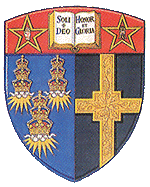Queen Mary University of London
Public research university in London, England
| Queen Mary University of London | |
|---|---|

| |
| Caption | N/A |
| Motto | Coniunctis Viribus |
| Established | 1887 |
| Type | Public |
| Principal | N/A |
| City | London |
| State | N/A |
| Country | England |
| Campus | Urban |
| Website | https://www.qmul.ac.uk/ |
Queen Mary University of London (QMUL) is a public research university in London, England, and a constituent college of the University of London. It was established in 1887 as the People's Palace and became a college of the University of London in 1915. The university has a strong reputation for research and teaching excellence, particularly in the fields of medicine, law, humanities, and engineering.
History[edit | edit source]
Queen Mary University of London has its origins in the People's Palace, a philanthropic endeavor to provide cultural and educational opportunities to the people of the East End of London. The institution was formally established in 1887 and became a college of the University of London in 1915. Over the years, it has expanded through mergers with other institutions, including St Bartholomew's Hospital Medical College and Westfield College.
Campuses[edit | edit source]
QMUL has several campuses across London, including:
The main campus is located in Mile End, which houses the majority of the university's academic departments and student facilities.
Academics[edit | edit source]
Queen Mary University of London offers a wide range of undergraduate and postgraduate programs across various disciplines. The university is organized into three faculties:
- Faculty of Humanities and Social Sciences
- Faculty of Science and Engineering
- Faculty of Medicine and Dentistry
The university is known for its research output and is a member of the prestigious Russell Group of research-intensive universities.
Research[edit | edit source]
QMUL is renowned for its research activities, particularly in the fields of medicine, dentistry, law, and humanities. The university has several research institutes and centers, including the Blizard Institute, the William Harvey Research Institute, and the Centre for Digital Music.
Student Life[edit | edit source]
Queen Mary University of London offers a vibrant student life with numerous clubs, societies, and sports teams. The Students' Union provides a range of services and activities to support and enhance the student experience.
Notable Alumni[edit | edit source]
QMUL has a diverse and accomplished alumni network, including notable figures in various fields such as politics, science, literature, and entertainment.
Related Pages[edit | edit source]
- University of London
- Russell Group
- St Bartholomew's Hospital Medical College
- Westfield College
- Blizard Institute
- William Harvey Research Institute
- Centre for Digital Music
References[edit | edit source]
Template:Universities in London
| Russell Group | ||
|---|---|---|
|
Search WikiMD
Ad.Tired of being Overweight? Try W8MD's NYC physician weight loss.
Semaglutide (Ozempic / Wegovy and Tirzepatide (Mounjaro / Zepbound) available. Call 718 946 5500.
Advertise on WikiMD
|
WikiMD's Wellness Encyclopedia |
| Let Food Be Thy Medicine Medicine Thy Food - Hippocrates |
Translate this page: - East Asian
中文,
日本,
한국어,
South Asian
हिन्दी,
தமிழ்,
తెలుగు,
Urdu,
ಕನ್ನಡ,
Southeast Asian
Indonesian,
Vietnamese,
Thai,
မြန်မာဘာသာ,
বাংলা
European
español,
Deutsch,
français,
Greek,
português do Brasil,
polski,
română,
русский,
Nederlands,
norsk,
svenska,
suomi,
Italian
Middle Eastern & African
عربى,
Turkish,
Persian,
Hebrew,
Afrikaans,
isiZulu,
Kiswahili,
Other
Bulgarian,
Hungarian,
Czech,
Swedish,
മലയാളം,
मराठी,
ਪੰਜਾਬੀ,
ગુજરાતી,
Portuguese,
Ukrainian
Medical Disclaimer: WikiMD is not a substitute for professional medical advice. The information on WikiMD is provided as an information resource only, may be incorrect, outdated or misleading, and is not to be used or relied on for any diagnostic or treatment purposes. Please consult your health care provider before making any healthcare decisions or for guidance about a specific medical condition. WikiMD expressly disclaims responsibility, and shall have no liability, for any damages, loss, injury, or liability whatsoever suffered as a result of your reliance on the information contained in this site. By visiting this site you agree to the foregoing terms and conditions, which may from time to time be changed or supplemented by WikiMD. If you do not agree to the foregoing terms and conditions, you should not enter or use this site. See full disclaimer.
Credits:Most images are courtesy of Wikimedia commons, and templates, categories Wikipedia, licensed under CC BY SA or similar.
Contributors: Prab R. Tumpati, MD






